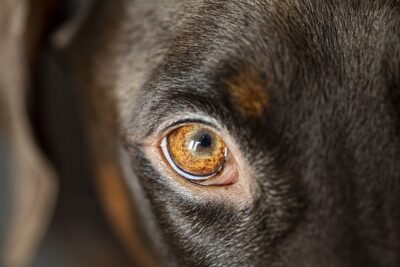Overview
Introduction to Can Dogs See In The Dark

Dogs’ eyes are equipped with adaptations that allow them to see in low-light conditions, addressing the question ‘Can Dogs See in the Dark?’ and giving them better night vision than humans. A key feature is the tapetum lucidum, a reflective layer behind the retina that enhances light capture.
This is why dogs’ eyes appear to glow green in the dark. Their larger pupils and higher concentration of rod cells in the retina also contribute to their ability to see in the dark. Understanding these adaptations helps us appreciate the remarkable night vision of our canine companions.
Dogs’ eyes are truly fascinating organs, allowing them to see in low-light conditions with remarkable clarity. This ability raises the question: Can dogs see in the dark as well as cats? Understanding the intricacies of canine night vision not only sheds light on our furry friends’ visual capabilities but also highlights the differences between dogs and cats in this aspect.
In this article, we’ll explore the fascinating world of a dog’s eyes and how they enable our canine companions to see in the dark.
We’ll delve into the science behind their better night vision, debunk some common myths, and provide tips on how to optimize your dog’s vision in low-light conditions. Let’s take a closer look at how can dogs see in the dark.
Importance of Night Vision for Dogs
The ability of dogs to see in low-light conditions, addressing the question ‘Can Dogs See in the Dark?’, is crucial for their survival and daily activities. With their good night vision, dogs can navigate and hunt in dimly lit environments more effectively. Their eyes’ ability to reflect light, making dog’s eyes glow green, enhances their vision at night.
This natural night vision is so effective that it has inspired the development of night vision goggles for military and police dogs, highlighting the importance of their exceptional visual capabilities in various fields.
Overview of Canine Eye Structure
A dog’s eyes are marvels of evolution, designed for both day and night vision, addressing the question ‘Can Dogs See in the Dark?’. They contain a high density of light-sensitive rods, which are essential for low-light vision and enable them to see in the dark.
This adaptation, along with a larger pupil size, allows more light to enter the eye, enhancing their ability to see in dim light. While dogs have dichromatic vision, meaning they see colors on a spectrum of blue and yellow, their superior night vision and reflective layer behind the retina, called the tapetum lucidum, contribute to their eyes appearing to glow green in the dark.
This combination of rods and cones in their retinas makes them well-adapted to a variety of lighting conditions.

How Dogs’ Eyes Adapt to Low Light Conditions
Tapetum Lucidum
Dogs’ eyes adapt to low light conditions thanks to a special reflective layer behind the retina called the tapetum lucidum.
This layer enhances the dog’s ability to see in the dark by reflecting light that has already passed through the retina back into it, giving the photoreceptor cells a second chance to detect the light.
While dogs can’t see in complete darkness, their vision works better than humans’ in dim light. The tapetum lucidum also aids in detecting movement, making dogs well-suited for activities in low light environments.
Rod Cells vs. Cone Cells
Dogs’ eyes adapt to low light conditions primarily through the use of rod receptors, which are highly sensitive to light and are responsible for nighttime vision. Rods outnumber cone cells in dogs’ retinas, making them more adept at seeing in dim light compared to humans.
While cone cells are responsible for color vision and detailed daylight vision, they are less effective in low light. This abundance of light-sensitive rods, along with the reflective tapetum lucidum, enhances dogs’ ability to navigate and see in low light conditions.
Pupil Size and Shape
In low light situations, a dog’s eyes adapt to enhance their vision. The pupils of a dog’s eye dilate in dim light, allowing more light to enter the eye.
This adaptation is crucial for improving a dog’s eyesight in the dark. Additionally, dogs have more rods in their retina than cones, which further aids in seeing in the dark by increasing sensitivity to light.
Conversely, in bright light, the dog’s pupils constrict to reduce the amount of light entering the eye, protecting the sensitive retina.

Can Dogs See in Complete Darkness?
Limitations of Canine Night Vision
While dogs have superior night vision compared to humans, they cannot see in complete darkness. Like most animals, including cats, dogs rely on some ambient light to see, as their eyes need at least some light to detect shapes and movement.
In total darkness, even a dog’s vision is limited, as their eyes require at least a minimal amount of light to function effectively.
Factors Affecting Night Vision Ability
While dogs have better night vision than humans, they cannot see in complete darkness.
Factors affecting their ability to see in the dark include the amount of ambient light available, the presence of reflective surfaces that can enhance available light, the breed (some breeds have better night vision than others), and individual differences in eye health and function.
Dogs’ eyes are adapted for low-light conditions, but they still require some light to see effectively.

Comparing Dog Night Vision to Human Night Vision
Differences in Eye Structure
Dogs’ night vision is superior to humans’ due to differences in eye structure. While humans have a higher concentration of cone cells for color vision and detailed daylight vision, dogs have more rod cells for better low-light vision.
Additionally, dogs have a larger visual field, allowing them to detect motion and objects in peripheral vision better than humans.
Despite this, humans rely more on other senses, like hearing and smell, to compensate for their inferior night vision compared to dogs.
Visual Acuity and Color Perception
While dogs can see in the dark better than humans, their visual acuity and color perception differ. While dogs can see shades of blue and yellow, they are unable to perceive the full range of colors that humans can.
This difference in color perception is due to the types of cones in their retinas, which are fewer in number than those in human retinas.

Understanding How Dogs Use Their Senses at Night
Enhanced Sense of Smell and Hearing
While dogs can see in the dark better than humans, they primarily rely on their enhanced sense of smell and hearing at night. Most dogs’ eyes glow in the dark due to the tapetum lucidum, a reflective layer behind the retina that enhances their night vision.
However, their sense of smell is their dominant sense, allowing them to detect scents from long distances, even in low light. Additionally, dogs have highly sensitive ears that can pick up faint sounds, further aiding in their navigation and awareness of their surroundings at night.
Combination of Senses for Navigation
While dogs can see in the dark better than humans, they rely on a combination of senses for navigation at night. While their night vision helps them detect movement and shapes, their sense of smell allows them to identify objects and track scents in the dark.
Additionally, their hearing is finely tuned to detect even subtle sounds, aiding in their navigation and awareness of their surroundings. The combination of these senses enables dogs to effectively navigate and interact with their environment in low-light conditions.

Common Myths about Dog Night Vision
Dogs Can See in Pitch-Black Darkness
One common myth about dog night vision is that they can see in pitch-black darkness. While dogs have better night vision than humans and can see in low light situations, they still require some ambient light to see effectively.
In complete darkness, dogs, like humans, rely more on their other senses, such as their keen sense of smell and hearing, rather than their vision.
This misconception likely arises from the reflective layer behind their retinas, the tapetum lucidum, which enhances their ability to see in dim light, but it doesn’t enable them to see in total darkness.
Dogs Have Color Vision at Night
One common myth about dog night vision is that they have color vision at night. While dogs do have some color vision during the day, their ability to see colors is reduced in low light situations.
At night, dogs rely more on their highly sensitive rod cells, which are more effective in detecting motion and shapes but do not perceive colors. This misconception likely stems from the assumption that dogs’ night vision is similar to their daytime vision, which is not the case.

Factors That Improve Dog Night Vision
Breed Variations in Night Vision
Factors that improve dog night vision include breed variations. Some dog breeds are better adapted to seeing in the dark due to differences in their eye structure and the density of their rod cells.
Breeds with larger eyes and a higher concentration of rods tend to have better night vision, as they can detect motion and shapes more effectively in low light conditions.
However, all dogs, regardless of breed, rely on their other senses, such as smell and hearing, to navigate and interact with their environment at night.
Age and Eye Health
Age and dog’s eye health are factors that can improve a dog’s night vision, including the impact of “cherry eye“. Younger dogs tend to have better night vision than older dogs, as their eyes are healthier and their vision is generally sharper.
Additionally, maintaining good eye health through regular check-ups and proper nutrition can help improve a dog’s ability to see in low-light conditions.
Dogs with eye conditions such as cataracts or progressive retinal atrophy may experience a decline in their night vision.

Can Dogs See Ghosts or Spirits in the Dark?
Scientific Explanation for Behavior
There is no scientific evidence to suggest that dogs can see ghosts or spirits in the dark. Instead, their behavior in dimly lit or dark environments is likely due to their keen senses, including their ability to detect subtle sounds, smells, and movements that humans may not notice.
Dogs’ behavior in such situations is more likely a response to their heightened sensory perception rather than any paranormal phenomenon.
Understanding Canine Behavior in Low Light
Dogs’ behavior in low light, addressing the question ‘Can Dogs See in the Dark?’, is more likely due to their heightened senses and natural instincts rather than seeing ghosts or spirits. In dimly lit environments, dogs rely more on their keen sense of smell and hearing to navigate and perceive their surroundings.
This behavior is a result of their evolutionary adaptation to detect potential threats and changes in their environment, rather than any supernatural ability to see ghosts or spirits.
Conclusion to Can Dogs See In The Dark
Recap of Canine Night Vision Abilities
Dogs’ eyes are equipped with adaptations that allow them to see in low-light conditions, addressing the question ‘Can Dogs See in the Dark?’ and giving them better night vision than humans.
Their superior night vision is attributed to a combination of factors, including the tapetum lucidum, a reflective layer behind the retina, a higher concentration of rod cells, and a larger pupil size. These adaptations enable dogs to navigate and hunt effectively in dimly lit environments.
Importance of Understanding and Accommodating Dog Night Vision
Understanding and accommodating dog night vision, including the question ‘Can Dogs See in the Dark?’, is essential for ensuring their safety and well-being. Providing adequate lighting, using reflective gear, and being aware of signs of poor night vision can help prevent accidents and discomfort for dogs.
By recognizing and appreciating the unique visual abilities of dogs, pet owners can create a safer and more comfortable environment for their canine companions.
Recognizing and appreciating the unique visual abilities of dogs allows pet owners to create a safer and more comfortable environment for their canine companions. Explore our delightful selection of puppies for sale in Georgia and surrounding areas. Each puppy is thoughtfully bred from reputable breeders and raised with love and care, guaranteed to meet your expectations and become a cherished addition to your family.
Frequently Asked Questions (FAQs) about Can Dogs See In The Dark
- Can dogs see in the dark better than humans?
- Yes, dogs can see in low-light conditions better than humans. Their eyes are adapted for night vision, with a higher concentration of rod cells in the retina, which are more sensitive to light than cone cells. Additionally, dogs have a reflective layer called the tapetum lucidum that enhances their night vision.
- Can dogs see in complete darkness?
- No, dogs cannot see in complete darkness. Like most animals, including cats, dogs need some ambient light to see. Their eyes require at least a minimal amount of light to detect shapes and movement effectively.
- Do dogs have better depth perception in the dark than humans?
- Dogs’ depth perception is not necessarily better than humans’ in the dark. While their eyes are adapted for night vision, allowing them to see better in low light, their depth perception is still influenced by the amount of light available.
- How does a dog’s vision in the dark compare to human vision?
- Dogs have better night vision than humans due to their eye structure, including a larger pupil size and a higher concentration of rod cells. While humans have better color vision and can see finer details during the day, dogs excel in detecting motion and shapes in low-light conditions.
- Can dogs see better in the dark than cats?
- Both dogs and cats have adaptations that allow them to see in low-light conditions, but they excel in different aspects. Cats have a higher number of rod cells in their retinas, giving them better night vision than dogs. However, dogs have a larger visual field and are better at detecting motion and objects in peripheral vision.




